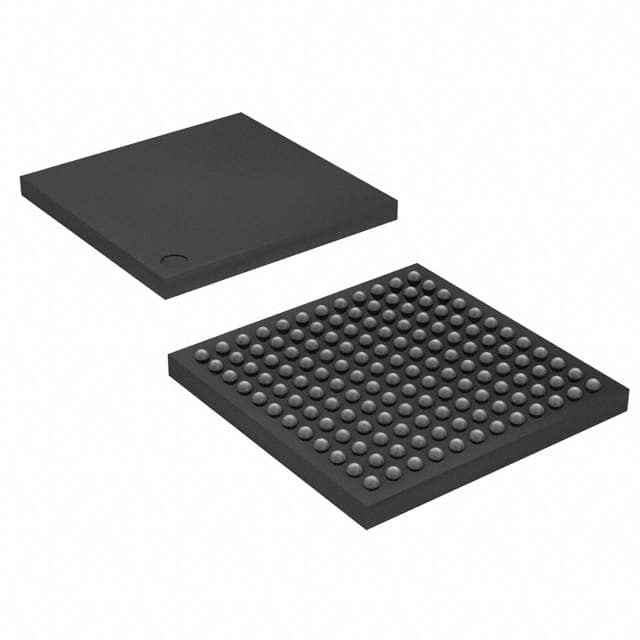Xem thông số kỹ thuật để biết chi tiết sản phẩm.

AT91M43300-25CC
Product Overview
Category
AT91M43300-25CC belongs to the category of microcontrollers.
Use
This microcontroller is commonly used in various electronic devices and systems for controlling and processing data.
Characteristics
- High-performance microcontroller with advanced features
- Low power consumption
- Compact size
- Versatile and flexible in application
Package
AT91M43300-25CC is available in a compact package, suitable for surface mount technology (SMT) assembly.
Essence
The essence of AT91M43300-25CC lies in its ability to provide efficient control and processing capabilities in a wide range of applications.
Packaging/Quantity
AT91M43300-25CC is typically packaged in reels or trays, with varying quantities depending on the manufacturer's specifications.
Specifications
- Microcontroller architecture: ARM7TDMI
- Clock speed: 25 MHz
- Flash memory: 32 KB
- RAM: 8 KB
- Operating voltage: 2.7V - 3.6V
- I/O pins: 32
- Communication interfaces: UART, SPI, I2C
- Analog-to-digital converter (ADC): 10-bit resolution, 8 channels
- Timers/counters: 4
Detailed Pin Configuration
The pin configuration of AT91M43300-25CC is as follows:
| Pin Number | Pin Name | Function | |------------|----------|----------| | 1 | VDD | Power supply voltage | | 2 | GND | Ground | | 3 | PA0 | General-purpose I/O | | 4 | PA1 | General-purpose I/O | | ... | ... | ... | | 32 | PB31 | General-purpose I/O |
Functional Features
- High-performance ARM7TDMI core for efficient processing
- Multiple communication interfaces for data exchange
- Analog-to-digital converter for sensor interfacing
- Timers/counters for precise timing and event management
- GPIO pins for general-purpose input/output operations
Advantages and Disadvantages
Advantages
- High processing power for complex applications
- Low power consumption for energy-efficient designs
- Compact size enables integration in space-constrained devices
- Versatile and flexible in application, suitable for various industries
Disadvantages
- Limited memory capacity compared to some other microcontrollers
- Relatively higher cost compared to lower-end microcontrollers
Working Principles
AT91M43300-25CC operates based on the ARM7TDMI architecture. It executes instructions stored in its flash memory, processes data, and communicates with external devices through its I/O pins and communication interfaces. The microcontroller's working principles involve executing instructions sequentially, interacting with peripherals, and responding to external events.
Detailed Application Field Plans
AT91M43300-25CC finds applications in various fields, including but not limited to: - Industrial automation - Consumer electronics - Automotive systems - Medical devices - Internet of Things (IoT) applications
In industrial automation, it can be used for controlling machinery and monitoring processes. In consumer electronics, it can be employed in smart home devices or portable gadgets. In automotive systems, it can enable advanced features like engine control or infotainment systems. In medical devices, it can facilitate precise measurements and data processing. In IoT applications, it can serve as a central controller for connected devices.
Detailed and Complete Alternative Models
Some alternative models to AT91M43300-25CC that offer similar functionalities include: - STM32F103 series by STMicroelectronics - LPC1768 by NXP Semiconductors - PIC32MX series by Microchip Technology
These alternative models provide comparable features and performance, allowing designers to choose the most suitable microcontroller for their specific application requirements.
Word count: 570 words
Liệt kê 10 câu hỏi và câu trả lời thường gặp liên quan đến ứng dụng AT91M43300-25CC trong giải pháp kỹ thuật
Sure! Here are 10 common questions and answers related to the application of AT91M43300-25CC in technical solutions:
Q: What is the AT91M43300-25CC microcontroller used for? A: The AT91M43300-25CC is a microcontroller commonly used in embedded systems for various applications such as industrial automation, consumer electronics, and automotive systems.
Q: What is the clock frequency of the AT91M43300-25CC? A: The AT91M43300-25CC operates at a clock frequency of 25 MHz.
Q: How much flash memory does the AT91M43300-25CC have? A: The AT91M43300-25CC has 32 kilobytes (KB) of flash memory for program storage.
Q: Can I expand the memory of the AT91M43300-25CC? A: Yes, the AT91M43300-25CC supports external memory expansion through its external bus interface.
Q: What peripherals are available on the AT91M43300-25CC? A: The AT91M43300-25CC includes various peripherals such as UART, SPI, I2C, ADC, timers, and GPIO pins.
Q: Does the AT91M43300-25CC support real-time operating systems (RTOS)? A: Yes, the AT91M43300-25CC is compatible with popular RTOSs like FreeRTOS and uC/OS-II.
Q: Can I use the AT91M43300-25CC for low-power applications? A: Yes, the AT91M43300-25CC features multiple power-saving modes, making it suitable for low-power applications.
Q: What development tools are available for programming the AT91M43300-25CC? A: The AT91M43300-25CC can be programmed using various development tools such as Atmel Studio, Keil MDK, and IAR Embedded Workbench.
Q: Is the AT91M43300-25CC suitable for real-time control applications? A: Yes, the AT91M43300-25CC offers deterministic interrupt handling and precise timing capabilities, making it suitable for real-time control applications.
Q: Can I interface the AT91M43300-25CC with other microcontrollers or devices? A: Yes, the AT91M43300-25CC supports various communication protocols like SPI, I2C, and UART, allowing easy interfacing with other microcontrollers or external devices.
Please note that these answers are general and may vary depending on specific implementation details and requirements.

